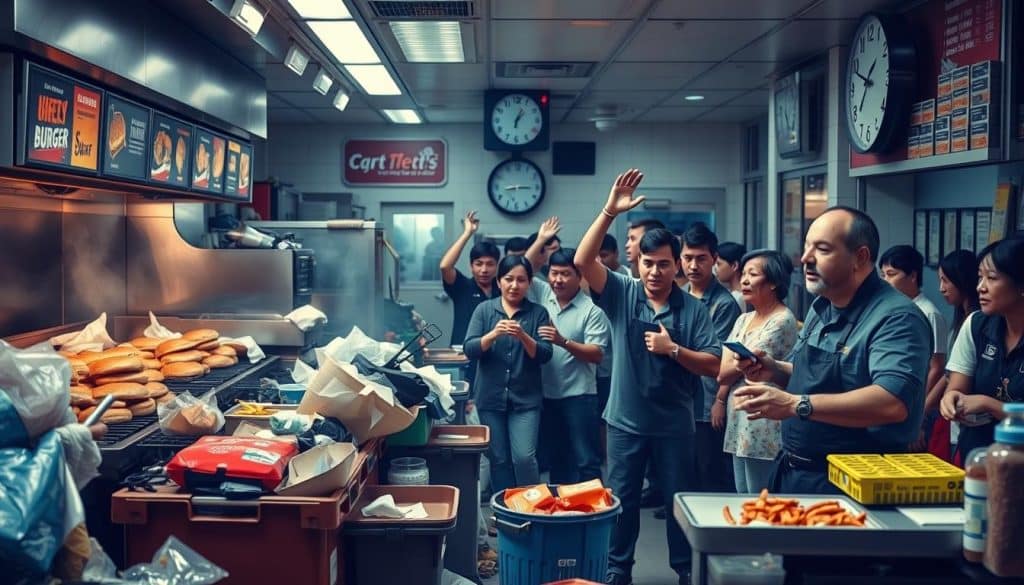Is investing in a fast food franchise a sure way to success, or just a risk? The fast food industry in the U.S. is worth a huge $402.9 billion. Many wonder if the top fast food franchises can bring the profits they dream of. Big names like McDonald’s, with 37,000 restaurants worldwide, serve 75 hamburgers every second.
New brands that focus on healthy food and use technology are also catching eyes. With the right knowledge of trends and investment advice, you can make smart choices in this booming field.
Key Takeaways
- The fast food industry is valued at $402.9 billion in the U.S.
- Understanding initial and recurring costs is vital when evaluating profitable fast food franchise businesses.
- Franchisees should ensure the brand focuses on customer satisfaction and loyalty for long-term success.
- Market research helps identify demographics, competition, and consumer preferences.
- Brands like Subway and KFC have successfully expanded their franchises globally, highlighting robust growth.
- Leveraging technology can enhance operational efficiency and improve customer experiences.
Overview of Fast Food Franchises in the U.S.
Fast food franchises are a special part of the franchise world. They let entrepreneurs run businesses under famous names. This way, people can start in the food business with help from big brands.
These franchises offer a complete setup, training, and support from the company. This makes starting a fast food business easier.
Definition and Characteristics
Fast food franchises make owning a restaurant simple. They give you a well-known brand, marketing help, and a set way to run things. This model is great for people who want quick, easy meals.
Fast food places often have menus that are easy to make and serve. This helps them serve customers fast.
Popularity and Market Demand
More people want fast food because of their busy lives. Fast food takes up about 10% of what families spend on food. The U.S. fast food market is growing, thanks to big names like McDonald’s and Subway.
These brands have thousands of places across the country. As people look for quick, cheap meals, these franchises keep doing well.
Top Fast Food Franchises to Consider
Investors looking into the fast food industry have many options. Both well-known brands and new players are available. These franchises offer a mix of classic and innovative choices, appealing to different tastes.
Established Brands
McDonald’s leads with over 38,000 locations worldwide. Almost 93% of these are owned by local business owners. Subway, with over 20,000 U.S. locations, looks for franchisees with experience.
Chick-fil-A and Taco Bell are also big names. Chick-fil-A has over 2,800 U.S. restaurants, while Taco Bell serves 40 million weekly through 7,200 locations. Dunkin’ and Wendy’s offer even more opportunities with their large number of locations.
Emerging Players
Newcomers like BCHEF are quickly gaining fans with their unique menus. Crumbl Cookies, with over 200 dessert flavors, is another example. These new franchises offer investors a chance to grow with new trends.
Regional Favorites
Whataburger and Zaxby’s are loved in their regions. Whataburger has over 890 locations, mainly in Texas. Zaxby’s, with over 900 locations in the Southeast, is known for its unique menu.
These regional favorites are great for investors. They offer a chance to serve local tastes and preferences, making the fast food market more diverse.
Current Trends Shaping the Fast Food Industry
The fast food industry is changing fast. It’s adapting to what people want and the market’s needs. Trends like health-conscious food, tech in fast food, and going green are big now.
Health-Conscious Choices
Fast food places are adding healthier options. Burger King has the Impossible Whopper for those who want plant-based food. This is a big change because people want to eat better.
Technology Integration
Technology is making fast food better. Taco Bell wants to double its online sales to $8 billion by 2023. Online orders and delivery are making it easier for people to get their food.
Sustainability Initiatives
Fast food is going green too. Companies are trying to be kinder to the planet. This makes customers happy and shows they care about the environment.
Key Factors to Evaluate When Investing in Franchises
Investing in fast food franchises involves many important factors. You need to understand the financial needs, the location’s impact, and the franchisor’s support. This ensures a smart decision.
Initial Investment and Fees
The costs for different fast food franchises vary a lot. It’s key to know these financial details. Franchise fees, royalties, and marketing costs are part of the investment.
It’s important to compare these costs with the possible earnings. About 80% of franchises fail in the first two years. So, carefully checking these financial aspects is vital for success.
Site Selection and Demographics
Choosing the right location is critical. A detailed market analysis is necessary. Look at demographics, competition, and local trends.
About 30% of franchisors limit locations due to market conditions. A good location can boost sales and make the business profitable.
Support and Training Provided
Franchise support is key to success. Good training and operational help are essential. They help franchisees overcome challenges.
65% of successful franchise owners say their success comes from the franchise’s support. Aligning personal values with the franchise leads to job satisfaction. This makes work more fulfilling.
Understanding Franchise Agreements
Franchise agreements are the base of any franchise deal. They outline the rules for how the business will run. Key parts include the initial fees, how much money is taken in royalties, and how long the deal lasts. Knowing these parts helps franchisees understand their duties and rights.
Key Components of Agreements
These agreements list different fees that franchisees must pay. Royalty rates can change a lot. For example, McDonald’s now takes 5% in royalties, up from 4%. Wendy’s and Burger King take between 4% to 6%. Subway asks for 8%.
Franchisees also have to pay for menu changes, new technology, and going green. Knowing all these costs helps them plan better.
Term Length and Renewal Options
Agreements usually last from 5 to 20 years, depending on the business. Fast-food places often last 10 years. Hotels might go up to 20 years because they need a lot of money.
Renewal periods are usually 5 to 10 years. During this time, franchisees must follow rules and pay a renewal fee. Knowing the length of the deal is key for long-term planning.
Franchisee Rights and Obligations
Franchisee rights and duties are very important. They set the rules for how the business runs and protect the franchisee. Knowing these rights helps franchisees make smart choices and work better with the franchisor.
Getting legal advice from a franchise lawyer can help. It’s important for complex agreements with rules on support, training, and extra investments.
Financial Performance of Fast Food Franchises
Understanding the financial side of fast food franchises is key for anyone thinking about investing. This look includes average revenue, profit margins, and success stories of top franchises.
Average Revenue and Profit Margins
The fast food industry is growing fast, with a forecasted $402.9 billion in 2024. This growth rate is 3.2% over the last five years. Big names like McDonald’s and Chipotle Mexican Grill lead the way with high profits.
McDonald’s has a profit margin of 45.4% and makes $1,635.3 million. Chipotle has a market share of 11,044.8% and a profit margin of 16.9%. Chick-Fil-A, with a 307.2% market share, makes $47 million and has a 15.3% profit margin.
As competition grows and people want healthier food, the numbers keep changing.
Case Studies of Successful Franchises
Looking at successful fast food franchises gives us clues on how to succeed. McDonald’s is a legend in the industry, always finding new ways to grow. Taco Bell recently saw a 4% increase in sales, showing it can thrive despite tough competition.
Tim Hortons, on the other hand, saw a 2.3% rise in sales. But, some like KFC U.S. and Pizza Hut faced drops. This shows how important it is to stay flexible and adapt to the market.
These stories show that success in fast food depends on many factors. But, focusing on the right numbers and strategies is key to staying ahead.

The Role of Marketing in Fast Food Franchises
Marketing is key for fast food franchises to succeed. Good branding makes them more visible and builds loyal customers. Brands like McDonald’s and Taco Bell show how marketing can connect with different people. They use fun campaigns that highlight what makes them special and affordable.
Branding and Customer Loyalty
Branding is vital for keeping customers coming back. People like brands that offer quality and value. Strong brands have rewards that make customers want to return.
They also create memorable promotions, like McDonald’s Happy Meals. These help customers, including kids, remember the brand. Kids often pick where to eat, so these promotions are important.
Digital Marketing Strategies
Digital marketing has changed a lot, with Instagram and TikTok being big for young people. Fast food places use these to share cool offers and new food. They also use data to make their marketing better.
Using things like Tastewise helps them know what people like. Quick offers can really help sales go up. A good marketing push can increase sales by 12%.
Challenges Faced by Fast Food Franchises
Fast food franchises face many challenges in their daily operations. The intense competition makes it hard for them to stand out. With more people caring about health and the environment, they need to innovate and adapt quickly.
To succeed, franchises must find ways to be unique while keeping their operations running smoothly.
Competition and Market Saturation
The fast food industry is very competitive, with over 200,000 quick-serve restaurants in the U.S. This crowded market can make it tough for franchises to keep their brand strong and profitable. They must find ways to be different from others.
Franchises compete not just with direct rivals but also with many other dining options. This includes casual dining and health-focused places.
Supply Chain Issues
Managing the supply chain is a big challenge for fast food franchises. Global events like the pandemic have made things harder. Disruptions can make it hard to keep products available and menus consistent.
Franchises also deal with rising costs and labor shortages. These issues make running operations even more complicated.
Changing Consumer Preferences
Today, people want healthier and more ethically sourced food. Fast food chains must innovate to meet these needs while keeping prices low. This can be tough, as franchises try to keep customers coming back despite changing tastes and diets.

Future Outlook for Fast Food Franchises
The future of fast food franchises is bright, with growth and new ideas on the horizon. Almost half of the top 50 new restaurant ideas are quick-service brands. This means more fast food in new places and for different people.
Fast-casual spots are less popular now, showing a big change in the industry. But, limited-service options are on the rise, moving away from full-service dining.
Growth Projections
Fast food chains are expected to grow fast, with a 40% increase in recent years. The International Franchise Association predicts a 2.5% growth for quick-service restaurants in 2023. New ideas like drive-thrus and AI are driving this growth.
People want to eat at places that care about the planet. In fact, 43% of diners are willing to pay more for eco-friendly restaurants.
Innovations on the Horizon
New tech is changing how fast food places serve customers. Domino’s Pizza uses AI to make service better, and Starbucks uses it for inventory. Drive-thrus and mobile orders are becoming common.
Brands are adding robots for cooking and packaging to work faster. They’re also using AI to make menus better fit what customers want. This shows how fast food will keep up with changing tastes.
Fast food franchises must meet many different customer needs while staying efficient. As tech and tastes change, the quick-service world is set for big changes. This makes it exciting for investors and entrepreneurs. To learn more about these changes, check out this article.
Conclusion and Final Investment Insights
Fast food franchises offer many investment chances, showing a big market trend. The global fast food market was over USD 672 billion in 2022. It’s expected to hit USD 897 billion by 2028. This makes it a great time to look for strong returns.
Successful investments need a deep understanding of money matters, good marketing, and keeping customers happy. This is key in a world where tastes are always changing.
Recap of Key Takeaways
Investors should really study franchise deals and what’s expected of them. Food prices have gone up by 29% in four years. The Quick Service Restaurant (QSR) segment makes over $250 billion a year, leading the franchise world.
Also, more people want tech and easy dining. This makes fast casual and QSR franchises great choices for investing.
Encouragement for Future Investors
Investing in fast food franchises is very important. It’s a chance to grow with big names like McDonald’s and new players. With the right plan and keeping up with trends, success is within reach.
This is the perfect time to dive into the fast food franchise world. It’s full of chances for growth and success.





